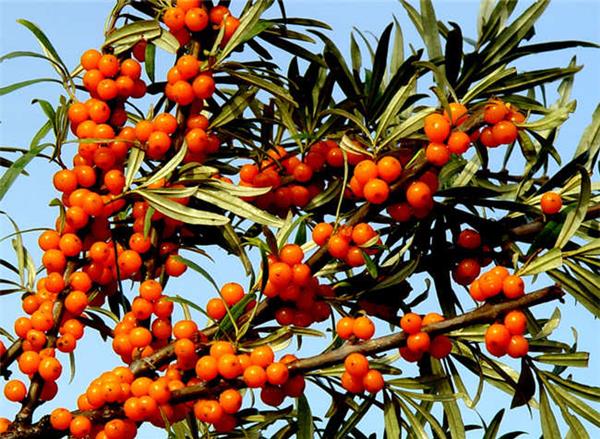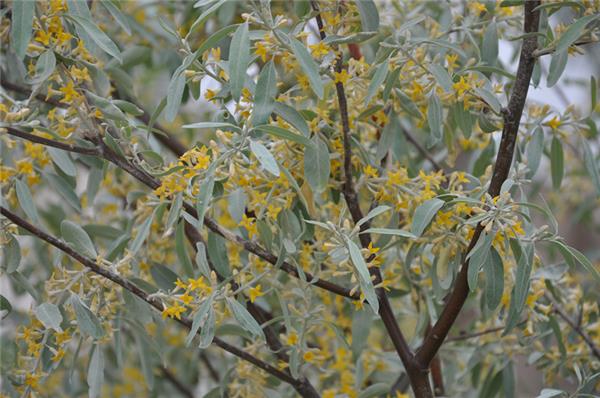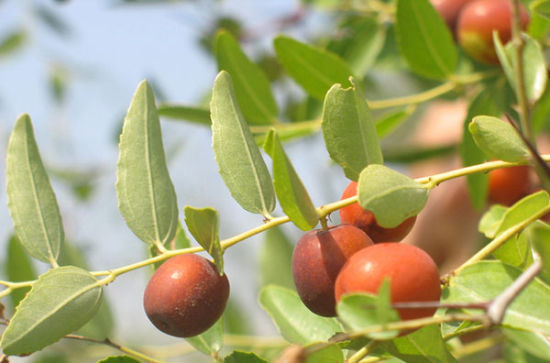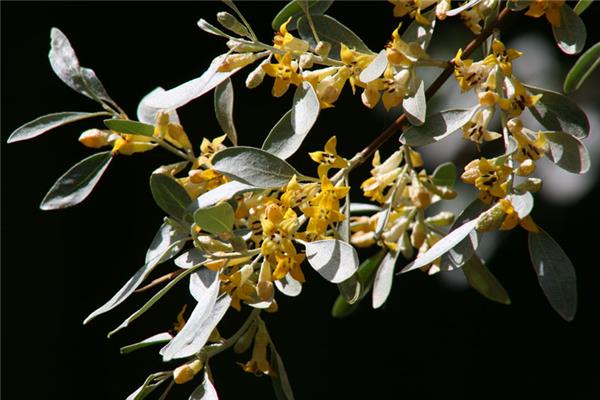The efficacy and Culture methods of Elaeagnus angustifolia
Elaeagnus angustifolia was a rather peculiar plant. Its trunk was not as straight as ordinary fruit trees, and its leaves were not as green as ordinary leaves. Although the fruits it produced were called dates, they were not as crisp and sweet as dates. Instead, they had a soft powder texture and tasted like mung bean cakes. Elaeagnus angustifolia was a specialty of the Northwest. Many people probably didn't know about it or even heard of it. So let's talk about this plant below.
1. Habits of Elaeagnus angustifolia
Elaeagnus angustifolia is a deciduous tree. It has strong vitality, rapid growth and easy reproduction. It has the characteristics of drought resistance, sand resistance, salt tolerance and barren tolerance. Natural Elaeagnus angustifolia is only distributed in desert and semi-desert areas where precipitation is less than 150 mm.

2. The efficacy and function of Elaeagnus angustifolia
1. Ornamental Value of Elaeagnus angustifolia
Elaeagnus angustifolia is a budding plant, suitable for cut flowers, mostly around the Spring Festival with poinsettia, narcissus and other compatibility.
2. The medicinal value of Elaeagnus angustifolia
Elaeagnus angustifolia L. is used as medicine with fruit. The ripe fruit is harvested in autumn. It is washed fresh or dried for later use. It has sweet and sour taste and mild nature. It has the effects of strengthening, calming, consolidating essence, strengthening stomach, relieving diarrhea, regulating menstruation and diuresis. It is mainly used for stomachache, diarrhea, weakness and cough due to lung heat. A concentrate of colloid and tannin obtained from the fruit of Elaeagnus angustifolia has anti-inflammatory effect; it can inhibit the motor function of small intestine in artificially induced diarrhea animals, so it can be used for enteritis.
3. Economic Value of Elaeagnus angustifolia
Its leaves and fruits contain nutrients needed by livestock and are high-quality feed for livestock. Elaeagnus angustifolia powder, but also wine, vinegar, soy sauce, jam, etc., dross can still be used for feeding. Elaeagnus angustifolia flowers, is a good source of honey plants, containing aromatic oil, can extract essence, spices. The sap can be extracted from Elaeagnus angustifolia gum, which is a substitute for Arabic gum. Elaeagnus angustifolia L. has become one of the main afforestation species in Northwest China.
4. Afforestation of Elaeagnus angustifolia
Elaeagnus angustifolia except for feeding, or a very good afforestation, greening, firewood, windbreak, sand-fixing species.

Third, the cultivation of Elaeagnus angustifolia precautions
1. seedling
Elaeagnus angustifolia seedlings are sowing seedlings and seedlings inserted.
Sowing seedlings: Sowing seedlings are mostly in spring. For spring seedlings, seed treatment should be carried out in December of the first winter. The method is to wash the seeds of Elaeagnus angustifolia, mix them evenly with equal amount of fine sand, put them into the seed treatment pit (80 cm deep, 100 cm wide, and the length depends on the number of seeds) dug in advance, or pile them on the ground according to the thickness of 40~60 cm, bury them with sand to form ridges around them, irrigate enough water (10~20 cm of accumulated water on the seeds), and after the water seeps down or freezes, cover them with sand for 20 cm to overwinter. The seeds that have not been stored in winter can be soaked in warm water at 50~60℃ for 2~3 days before sowing. After being taken out, they are mixed with horse manure and placed in the sun to moisturize and germinate. After 30~40% of the seeds are cracked, they can be sown. Seeds sown in autumn need not be germinated.
Cutting seedlings: selecting annual branches with good lignification, no diseases and insect pests and full lateral buds as cutting strips. The cuttings collected from the field are cut into cuttings according to the length of 15~20cm. The cutting angle is 45° or even truncated. When cutting, special attention should be paid to protecting the first lateral bud at the upper end of the cutting. The upper incision should be cut flat and cut at about 1cm above the first bud. The lower incision should be selected at the base of the first bud. Most of them are inserted in spring, but they can also be inserted in autumn. Spring planting should be early, generally before axillary bud germination, autumn planting before soil freezing.

2. Temperature and humidity: The optimum temperature for the rooting of Elaeagnus angustifolia is 20℃~30℃, and the relative humidity of the air must be maintained at 75~85% after the rooting.
3. Light: In Elaeagnus angustifolia inserted after the sun must be blocked off 50~80%, after the root growth, and then gradually remove the shading net. Remove the shade at 4:00 p.m. every day on a sunny day and cover it by 9:00 a.m. the next day.
3. Pruning: after the trees are covered, the sprouting branches at the roots should be removed, the lateral branches below 1/2 of the trunk and the upper lateral branches affecting the growth of the trunk should be pruned. Later, according to the growth potential of the trees, appropriate spacing, thinning, and pruning and shaping should be carried out.
4. pest management
Disease: Cinnamomum angustifolia brown spot disease is one of the important diseases of Elaeagnus angustifolia seedlings and young forests. The disease spots of Elaeagnus angustifolia grow on the leaves, and brown to yellow spots are formed on the front of the diseased leaves, which are small at first, 2~3mm, and gradually expand to 5~8 mm. Nearly round or irregular, often confluent into large spots, diseased leaves dry off. The spots are scattered with yellow-brown to black-brown dots, i.e. conidia. Abaxial surface of leaf is not marked by dense white tufts.
Insect pests: Elaeagnus angustifolia, Elaeagnus angustifolia and Elaeagnus angustifolia are common diseases and insect pests of Elaeagnus angustifolia. In terms of protection, one is to protect and utilize natural enemies such as spiders and ladybugs to prey on adults and parasitic nymph of biting wasps; the other is to strengthen tending management such as fertilizer and water to enhance insect resistance; the third is to coat white dry base in winter or early spring or dry with 60% D-M mixture 200 times solution.

How about, through the above introduction, do you have a deeper understanding of this strange plant? Although Elaeagnus angustifolia may not seem suitable for indoor farming, if you have a courtyard or terrace in your home, you may wish to try farming Elaeagnus angustifolia.
How about, through the above introduction, do you have a deeper understanding of this strange plant? Although Elaeagnus angustifolia may not seem suitable for indoor farming, if you have a courtyard or terrace in your home, you may wish to try farming Elaeagnus angustifolia.
- Prev

[efficacy and function of Golden scented Tea] what are the functions of Golden scented Tea
[efficacy and function of Golden scented Tea] what are the functions of Golden scented Tea
- Next

How does bitter chicory eat bitter chicory and how to raise it?
How does bitter chicory eat bitter chicory and how to raise it?
Related
- Wuhan Hospital Iron Tree Blooming Result Was Instantly Frightened by the Gardener Master
- Which variety of camellia is the most fragrant and best? Which one do you like best?
- What is the small blue coat, the breeding methods and matters needing attention of the succulent plant
- Dormancy time and maintenance management of succulent plants during dormancy
- Minas succulent how to raise, Minas succulent plant pictures
- What are the varieties of winter succulent plants
- How to raise succulent plants in twelve rolls? let's take a look at some experience of breeding twelve rolls.
- Attention should be paid to water control for succulent plants during dormant period (winter and summer)
- Watering experience of twelve rolls of succulent plants
- Techniques for fertilizing succulent plants. An article will let you know how to fertilize succulent plants.

